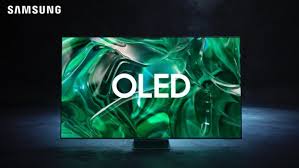
In the vast realm of television technology, two titans stand tall, each vying for the top spot in your living room: QLED and OLED. These acronyms represent two cutting-edge display technologies that have revolutionized the way we experience entertainment. In this blog post, we’ll delve into the intricacies of QLED vs OLED, unraveling their differences and helping you decide which TV is better suited for your viewing pleasure.

Understanding QLED: QLED, or Quantum Dot LED, is a display technology pioneered by Samsung. At its core, QLED employs a backlight system that utilizes quantum dots, tiny semiconductor particles, to enhance the color and brightness of the screen. These dots emit precise colors when exposed to light, resulting in vibrant and lifelike images.
Benefits of QLED:
- Brightness Brilliance: QLED TVs are renowned for their exceptional brightness levels, making them ideal for well-lit rooms and vivid HDR content.
- Longevity: Quantum dots are known for their durability, ensuring that QLED TVs maintain their stunning visuals over an extended period.
- Affordability: Generally more budget-friendly than OLED counterparts, QLED TVs provide an excellent compromise between performance and cost.

Understanding OLED: OLED, or Organic Light Emitting Diode, takes a fundamentally different approach. Instead of utilizing a backlight, each pixel in an OLED display emits its own light. This results in true blacks and infinite contrast ratios since individual pixels can be turned off completely.
Benefits of OLED:
- Perfect Blacks: With no need for a backlight, OLED TVs can achieve absolute black levels, enhancing contrast and overall picture quality.
- Wide Viewing Angles: OLED screens maintain consistent colors and brightness levels even when viewed from sharp angles, providing an immersive experience from any vantage point.
- Thin and Flexible Design: The absence of a backlight allows OLED TVs to be incredibly thin and flexible, enabling innovative and sleek designs.
Choosing the Right TV for You: When it comes to deciding between QLED and OLED, it ultimately boils down to personal preferences and budget considerations.
- Choose QLED If:
- You prioritize a bright and vibrant display.
- Long-term durability is a significant factor for you.
- Budget constraints play a crucial role in your decision-making.
- Choose OLED If:
- Perfect blacks and infinite contrast ratios are essential for your viewing experience.
- You prefer wide viewing angles for a more inclusive home theater setup.
- Design and aesthetics are high on your priority list.

Major differences between QLED and OLED (QLED VS OLED)
- Display Technology:
- QLED: Utilizes an LED-backlit LCD (Liquid Crystal Display) panel with a layer of quantum dots placed in front of the backlight. Quantum dots enhance color and brightness.
- OLED: Uses an organic compound layer that emits light when an electric current is applied. Each pixel in an OLED display is a self-contained light source.
- Contrast and Blacks:
- QLED: While QLED TVs offer excellent contrast, they rely on a backlight, making it challenging to achieve true blacks. Local dimming is used to enhance contrast by selectively dimming specific zones of the backlight.
- OLED: Achieves true blacks as individual pixels can be turned off completely. There is no need for a backlight or local dimming.
- Brightness:
- QLED: Known for its impressive brightness levels. Suited for well-lit rooms and HDR content.
- OLED: Generally not as bright as QLED, but it compensates with superior contrast ratios.
- Viewing Angles:
- QLED: Viewing angles are good, but colors and brightness may degrade when viewed from extreme angles.
- OLED: Maintains consistent colors and brightness levels even at sharp angles, offering wider viewing angles.
- Response Time:
- QLED: Typically has a faster response time than OLED, making it better for fast-paced content like gaming or sports.
- OLED: May exhibit slight motion blur in fast-moving scenes.
- Durability:
- QLED: Quantum dots are durable, and QLED TVs have a longer lifespan compared to older LCD technologies.
- OLED: Organic compounds in OLED panels can degrade over time, potentially leading to image retention or burn-in issues, though modern OLED TVs incorporate features to mitigate these concerns.
- Thickness and Flexibility:
- QLED: Thicker than OLED due to the need for a backlight. Generally less flexible in terms of design.
- OLED: Inherently thin and flexible as it doesn’t require a backlight. Enables innovative and sleek designs.
- Cost:
- QLED: Generally more budget-friendly than OLED TVs, making them accessible to a broader market.
- OLED: Typically more expensive due to the complexity of the manufacturing process and the premium features offered.
- Color Accuracy:
- QLED: Offers excellent color accuracy, especially when combined with quantum dot technology. Colors can be vibrant and true to life.
- OLED: Known for exceptional color accuracy and saturation. Each pixel emits its own light, contributing to precise color reproduction.
- HDR Performance:
- QLED: Excels in HDR (High Dynamic Range) content delivery, providing bright highlights and a wide range of colors. Some QLED models support high peak brightness levels.
- OLED: Offers impressive HDR performance with deep blacks, making it well-suited for HDR content. However, peak brightness may be comparatively lower than high-end QLED TVs.
- Energy Efficiency:
- QLED: Generally consumes more power, especially in scenes that require high brightness levels. The backlight is always on.
- OLED: More energy-efficient as each pixel produces its own light, allowing for precise control and lower power consumption, especially in dark scenes.
- Gaming Features:
- QLED: Often equipped with gaming-focused features like variable refresh rate (VRR), low input lag, and high refresh rates, making them popular among gamers.
- OLED: While OLED TVs provide excellent image quality, some models may have slightly higher input lag. However, many modern OLED TVs include gaming-centric features to address this.
- Uniformity:
- QLED: May exhibit issues such as backlight bleeding or clouding, especially in dark scenes. Local dimming is employed to mitigate these issues.
- OLED: Offers superior uniformity with each pixel emitting its own light. There is no backlight, reducing the likelihood of uniformity issues.
Conclusion: In the QLED vs. OLED showdown, there is no definitive winner; it’s about finding the perfect match for your unique preferences and requirements. Whether you lean towards the brilliant brightness of QLED or the mesmerizing contrast of OLED, both technologies promise an unrivaled visual feast for your entertainment needs. So, pick your side in the screen battle and elevate your TV viewing experience to new heights!










